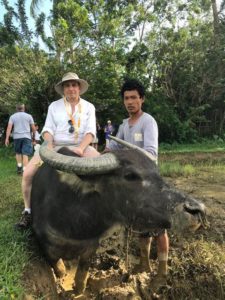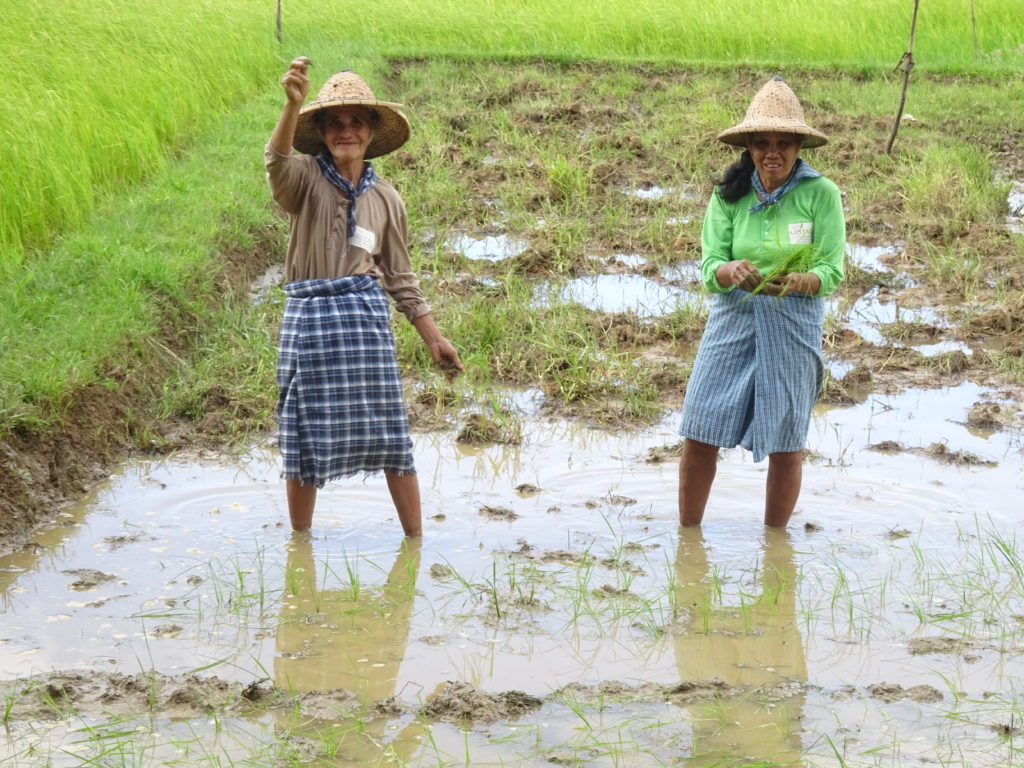 The Philippines consists of 7,641 islands, although about 500 of them disappear at high tide. While the nation has growing industrial and service industries, about 30% of the labor force remains in agriculture, with rice as its biggest commodity.
The Philippines consists of 7,641 islands, although about 500 of them disappear at high tide. While the nation has growing industrial and service industries, about 30% of the labor force remains in agriculture, with rice as its biggest commodity.
I’ve always had a special affinity for rice. One of my first assignments as an environmental consultant was to tour the southern US to locate collaborators for a study for a new rice pesticide. I roamed the fields of Louisiana, Arkansas, Mississippi, and Texas. Years later I found myself in southeast Asia noting the prevalence of rice (and noodles) in the diet.
During my recent trip to the Philippines I had several occasions to get a better understanding how important rice is the to the local diet and way of life. Here’s just one example. I visited the Motag Living Museum on the northwestern tip of Panay Island, a short speedboat ride from the tourist island of Boracay. The museum consists of a series of traditional huts and workspaces. Women show how traditional crafts – baskets, toys, clothes, tools – are made, while both men and women highlight the methods of ploughing, harrowing, planting, threshing, pounding, and then cooking, rice.
Rice is a basic source of starch, much like pasta and potatoes in Europe and the United States, but I was surprised to learn that they also make the equivalent of popcorn (pop-rice?) and hard grain rice snacks. Rice fibers can also be used as toilet paper. I passed on the invitation to roll up my pants and plant new rice fronds in the muddy rice field, but jumped at the chance to ride a water buffalo (called a carabao in the Philippines) around the same mud plot. I also used a bamboo pole as a bucket to lift water from a well, fill another bamboo pole as a carrier, and tote the water to an area for washing and showering.
 My science education also didn’t stop with rice. Motag also showed us how to hack coconuts out of their outer husk using a sharp stick, then use another sharp stick to break up the coconut meat into flakes. We also got to taste coconut water and coconut milk. Coconut also played a role (no pun intended) as “paper” at the local toilet hole. Mixing coconut flakes with water makes a handy shampoo, while a coconut and leaves blend works great as a natural soap. These seemed to work better than the leaves sometimes used at the hole and sometimes to sandpaper the bark off trees (for which it worked way too well). Later I would enjoy the traditional coconut pie and 80-proof coconut wine/liquor.
My science education also didn’t stop with rice. Motag also showed us how to hack coconuts out of their outer husk using a sharp stick, then use another sharp stick to break up the coconut meat into flakes. We also got to taste coconut water and coconut milk. Coconut also played a role (no pun intended) as “paper” at the local toilet hole. Mixing coconut flakes with water makes a handy shampoo, while a coconut and leaves blend works great as a natural soap. These seemed to work better than the leaves sometimes used at the hole and sometimes to sandpaper the bark off trees (for which it worked way too well). Later I would enjoy the traditional coconut pie and 80-proof coconut wine/liquor.
I finished up my visit with a cup of hot lemongrass and ginger tea, followed by leaf-wrapped sticky rice.
The short local minibus ride back to the boat squeezed passed the row of moto-tricycles waiting for their charges as the local high school emptied out its students. Along the way back to the pier we saw acres and acres of rice fields squeezed between the shoreline and mountains. Much of the Philippines was severely damaged by Super Typhoon Haiyan (called Yolanda in the Philippines) in 2013. A 7.1 level earthquake hit the area a month prior to the typhoon. Luckily, the Philippines gets all its energy from geothermal, wind, solar, and hydroelectric, so they were able to recover fairly well.
Suddenly I feel an urge to eat some pop-rice. Perhaps this is an unexplored market in the west.
David J. Kent is an avid science traveler and the author of Lincoln: The Man Who Saved America, in Barnes and Noble stores now. His previous books include Tesla: The Wizard of Electricity and Edison: The Inventor of the Modern World and two e-books: Nikola Tesla: Renewable Energy Ahead of Its Time and Abraham Lincoln and Nikola Tesla: Connected by Fate.
Check out my Goodreads author page. While you’re at it, “Like” my Facebook author page for more updates!











Interesting that you were involved with US rice production. Buying a small bag of rice in a US grocery store once elicited a curious comment from the young checker. I noted that rice is the staple food for well over half of the world’s population, and that many people in Asia may eat more than twice their own body-weight in dry rice over a year. In a typical Japanese kitchen, the single most expensive appliance may well be the rice-cooker. It’s difficult to overestimate the importance of rice to the world’s human population.
As for coconuts in the Philippines, in my experience they were something like corn in the US. Cheap passage between many islands could be found on “copra” (old coconuts) barges. Rather stinky… these are the brown things Americans usually find in stores. In the Philippines, they were broken up and used for pig feed.
It was more I was involved in making sure the pesticides used didn’t wipe out the surrounding wildlife.
Given my trips to Asia (and love of sushi), I knew that rice was important but didn’t really have a grasp of just how much. So this trip was especially educational for me. Plus I got to ride a water buffalo, which I never thought I would ever say.
Didn’t know about the pig feed, but it doesn’t surprise me. One thing I noticed is that they use all of the natural resources around them – building, clothes, food, toys, etc. I was also interested to find out that there is still a good amount of mahogany trees there. I had thought they were pretty much wiped out. There are certainly more scarce in general, but they still could be found locally and used for buildings and ox carts.
With regard to rice production in California, water is the controversy. Government water subsidies long allowed for the growing of rice in the central valley, where in some places fossil-aquifer wells are 3,000 feet deep and the land has subsided by as much as 28-feet. Ironically, most Japanese prefer starchy “Calrose” over aromatic Southeast Asian “Jasmine” rice as an imported substitute for Japanese rice. That’s much of what drives the market for California rice production.
Interesting observation about the careful use of natural resources. Perhaps a good measure of “wealth” might hinge upon how much one can afford to throw-away or to waste.
Thanks for the additional info on California rice production since I never got out there when I was working the project.
As for wealth, Americans do tend to use quite a bit more resources per capita than the rest of the world. Sadly.